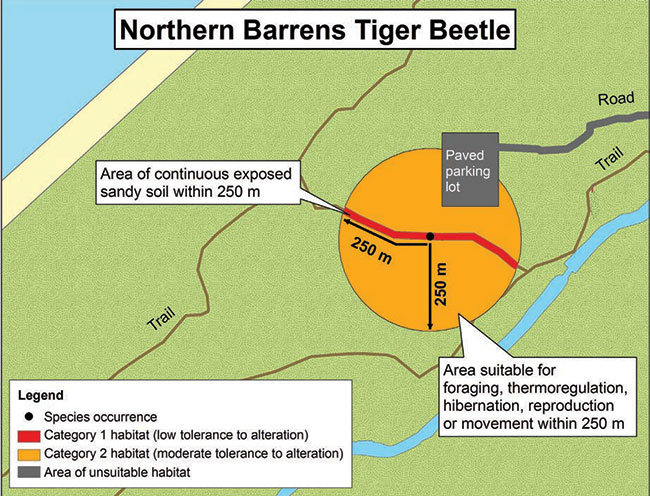Northern Barrens Tiger Beetle Habitat Protection Summary
This document provides a brief description of the area that is protected as habitat for the Northern Barrens Tiger Beetle through a habitat regulation under the Endangered Species Act.
Northern Barrens Tiger Beetle is a relatively small, globally rare ground beetle. It is dull metallic green in colour and lives in sandy openings in pine and pine-oak woodlands. The species was assessed by the Committee on the Status of Species at Risk in Ontario (COSSARO) and listed as endangered on March 18, 2010. More information about the species' status can be found at: Northern barrens tiger beetle Scientific name: Cicindela patruela.
The habitat regulation for Northern Barrens Tiger Beetle protects areas of exposed sandy soil, such as trails, hydro corridors, access roads and fire breaks that are continuous and within 250 metres of an area being used by a Northern Barrens Tiger Beetle. Areas suitable for foraging, thermoregulation, hibernation, reproduction or movement within 250 metres of an area being used by a Northern Barrens Tiger Beetle are also protected. These areas are protected until five consecutive years of documented non-use.
The regulation applies where the beetle occurs in the geographic Township of Bosanquet, within the County of Lambton. As of May 2012, the only known occurrences of this beetle are within The Pinery Provincial Park.
Supporting rationale
- Northern Barrens Tiger Beetle depends on areas of exposed sandy soil adjacent to vegetated areas to carry out its life processes. A distance of 250 metres is intended to protect the home range and seasonal movements of a Northern Barrens Tiger Beetle.
- The five-year term represents two-times the life span of a Northern Barrens Tiger Beetle, plus an additional year to account for unusual climate conditions or weather events that may affect population numbers in any given year.
Activities in Northern Barrens Tiger Beetle habitat:
Activities in regulated habitat can continue as long as the function of these areas for the species is maintained and individuals of the species are not killed, harmed, or harassed.
Generally compatible:
- Hiking on existing walking trails.
- Continuation of most existing trail maintenance practices.
Generally not compatiblefootnote 1 :
- Use of motorized vehicles and bicycles along walking trails.
- Altering or removing an exposed sandy area.
- Significant reduction or clearing of vegetation adjacent to sandy areas.
Key terms:
- Thermoregulation: Some animals, such as insects, use thermoregulation to alter their internal body temperature through behavioural patterns, such as basking in the sun to increase body temperature or seeking out cool areas to lower body temperature.
Below you will find an example diagram of how this regulation would be applied to protect habitat for this species. It indicates how the protected habitat has been categorized, based on how the species uses the habitat and how much activity or change can occur within the habitat, as per the policy "Categorizing and Protecting Habitat Under the Endangered Species Act".
Sample application of the Habitat Regulation
Figure 1: Northern Barrens Tiger Beetle map

Enlarge Figure 1: Northern Barrens Tiger Beetle map
The content of this summary is provided for convenience only. For accurate reference and the most recent version of the regulation, please view Ontario Regulation 832/21 on e-Laws
Footnotes
- footnote[1] Back to paragraph If you are considering an activity that may not be compatible with regulated habitat, please contact your local MNR office for more information